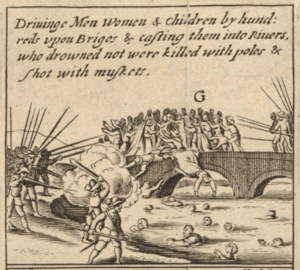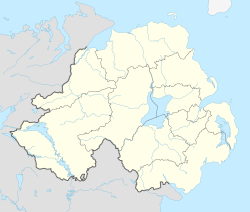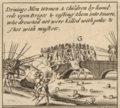Portadown massacre facts for kids
Quick facts for kids Portadown massacre |
|
|---|---|
| Part of the Irish Rebellion of 1641 | |

Engraving of the massacre by Wenceslaus Hollar, published in James Cranford's Teares of Ireland (1642)
|
|
| Location | Portadown, County Armagh, Ireland |
| Coordinates | 54°25′16″N 6°27′30″W / 54.421027°N 6.458244°W |
| Date | November 1641 |
|
Attack type
|
Drowning, shooting |
| Deaths | c.100 |
| Perpetrators | Irish rebels |
The Portadown massacre happened in November 1641 in Portadown, County Armagh, during the Irish Rebellion of 1641. During this event, Irish Catholic rebels killed about 100 British Protestant settlers. They forced the settlers off a bridge into the cold River Bann. Those who tried to swim to safety were shot.
The settlers were being moved from a prison camp at Loughgall. This was the largest killing of Protestants during the rebellion. It was also one of the bloodiest events during the Irish Confederate Wars. The Portadown massacre, and similar events, made Protestants in Ireland and Great Britain very afraid. These events were later used to support the Cromwellian conquest of Ireland. They were also used to argue against giving more rights to Catholics.
Contents
Why the Rebellion Started
The Irish rebellion began in Ulster on 23 October 1641. It started as an attempt by Catholic nobles and soldiers to take control of the English government in Ireland. They wanted King Charles I to agree to several things. These included ending unfair treatment against Catholics. They also wanted more self-rule for Ireland. Finally, they wanted to get back some or all of the lands that had been taken from Irish families.
Many rebels had lost their family lands over the past thirty years. This happened during the plantation of Ulster. This was when the English Crown took land and gave it to Protestant settlers from England and Scotland.
Most of the land at Portadown had belonged to the McCanns, a Gaelic Irish family. As part of the plantation, the English Crown took this land. It was then settled by English and Scottish Protestants. Rebels, including the McCanns, captured Portadown on the first day of the rebellion. They also took nearby places like Tandragee and Charlemont.
Some rebels started attacking and robbing Protestant settlers. However, rebel leaders tried to stop this violence. One historian, Nicholas Canny, suggests the violence got worse after rebels failed to attack Lisnagarvey in November 1641. After this, the settlers killed many captured rebels. This act of revenge by the settlers deeply affected the rebels. It seems to have led to more killings of English settlers.
What Happened at the Massacre
Twenty-eight people gave statements about the massacre. But only one person actually saw it happen. The others shared what they had heard, possibly even from some of the rebels.
William Clarke was the only known survivor. He said he had been held in a prison camp at Loughgall. Many prisoners there were treated badly. Clarke stated that he and about 100 other prisoners were marched six miles. Their destination was the bridge over the River Bann at Portadown. The wooden bridge was broken in the middle.
Clarke said the prisoners were stripped of their clothes. Then, rebels threatened them with swords and pikes. They were forced off the bridge and into the cold river below. Those who tried to swim to safety were shot with muskets. Clarke claimed he managed to escape by paying the rebels.
The massacre likely happened in mid-November. It seems the prisoners were being taken to the coast to be sent to Britain. Rebel leader Felim O'Neill had already sent other groups of prisoners safely to Carrickfergus and Newry. Toole McCann was the rebel captain in charge of the Portadown area at that time. Several people stated that he was responsible for the massacre. Historian Hilary Simms writes that the prisoners entered his area. It is likely he and his men were involved, even if he did not order it.
What Happened After
As news of the massacre spread, parts of the story were made bigger or changed. People who heard about the massacre gave different numbers for the dead, from 68 to 196. Since William Clarke was a witness, his number of 100 is seen as the most believable.
Still, the Portadown massacre was one of the bloodiest events in Ireland during the Irish Confederate Wars. About 4,000 Protestant settlers were killed in Ulster in the early months of the rebellion. In County Armagh, recent studies show about 1,250 Protestants were killed. This was about a quarter of the settler population there.
There were also killings of local Catholics. For example, at Islandmagee in County Antrim, and on Rathlin Island by Scottish soldiers. A historian from the 1800s, William Lecky, who supported British rule, wrote that it was unclear which side was more cruel.
The massacre made Protestant settlers very scared. It was used to support the idea that the rebellion was a Catholic plan to kill all Protestants in Ireland. However, in truth, most such killings were only in Ulster.
In 1642, an investigation was held into the killings of settlers. Protestant bishop Henry Jones led the inquiry. He read some of the evidence to the English parliament in March 1642. However, most of his speech was based on what he had heard from others.
The massacre was used a lot in English Parliamentarian propaganda in the 1640s. This was especially true in John Temple's book The Irish Rebellion (1646). Temple used the massacres at Portadown and other places to push for England to take back control of Ireland by force. He also wanted to separate Irish Catholics from British Protestants.
Stories of the massacre made many Parliamentarians determined to conquer Ireland again. They did this in 1649–52. During this conquest, Oliver Cromwell's army also committed massacres. This led to the taking of most Catholic-owned land and many people being forced to leave. Temple's book was published many times between 1646 and 1812. The terrible massacres described in it were used to argue against giving more rights to Catholics.
After the massacre, stories spread of ghosts appearing in the river at Portadown. They were said to be screeching and crying for revenge. These stories reportedly scared the local people. One woman said that Irish Confederate commander Owen Roe O'Neill visited the massacre site when he returned to Ireland in 1642. She stated that a female ghost appeared, crying for revenge. O'Neill sent for a priest to speak to the ghost. But it would only speak to a Protestant priest from an English army group.
Toole McCann was later captured by English forces. He was questioned and gave a statement in May 1653. He said he had not ordered or seen the massacre, but had only heard about it. He was executed shortly after.
Images for kids



